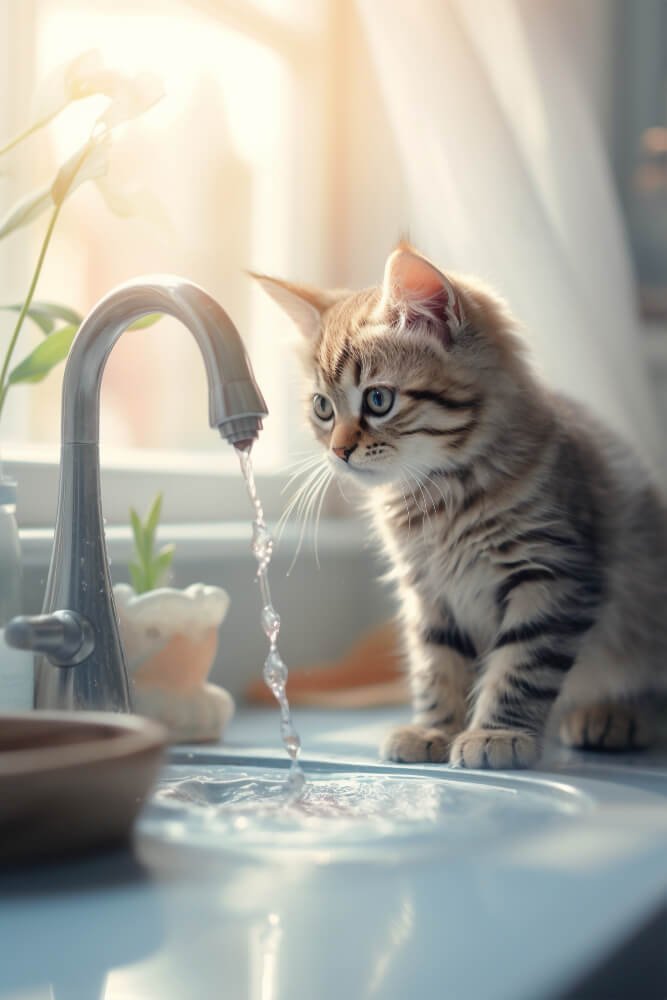Not only can this lead to unpleasant odors and unsightly stains, but it can also put your cat’s health at risk. Dirty bowls can cause infections, digestive problems, and even lead to illnesses like feline acne. That’s why it’s important to make cleaning your cat’s bowls a regular part of your household cleaning routine.
But how often should you be washing your cat’s bowls? And what’s the best way to clean them? Best practice is to rinse your cat’s bowls every day and thoroughly clean them at least once a week. Let’s take a closer look.
How Often to Wash Your Cat’s Food and Water Bowls?
The frequency with which you should clean your cat’s bowls depends on a few factors, including how many cats you have and how often they eat and drink. As a general rule, it’s a good idea to wash your cat’s bowls once a day. This ensures that they always have access to fresh, clean water and helps prevent the buildup of harmful bacteria.
If you have multiple cats, you may need to wash the bowls more frequently to keep up with their food and water consumption. It’s also a good idea to clean the bowls more often during hot weather or if your cat is sick, as they may be drinking more water than usual.
In addition to daily cleaning, it’s a good idea to do a deep clean of your cat’s bowls once a week. This involves soaking the bowls in hot, soapy water and scrubbing them with a brush to remove any stubborn stains or buildup.
Signs That It’s Time to Clean Your Cat’s Bowls
Even if you’re washing your cat’s bowls on a regular basis, there are some signs that it’s time for a deep clean. If you notice any of the following, it’s a good idea to give the bowls a thorough washing:
- Stains or discoloration on the bowls
- A foul odor coming from the bowls
- Slimy or sticky residue on the bowls
- Your cat is avoiding the bowls or not drinking as much water as usual
These signs could indicate a buildup of bacteria or other harmful microorganisms in the bowls. By giving them a deep clean, you’ll not only eliminate any germs but also ensure that your cat is happy and healthy.
Different Methods for Cleaning Your Cat’s Bowls
When it comes to cleaning your cat’s bowls, there are a few different methods you can use. Here are some of the most popular:
Hand-washing
Hand-washing your cat’s bowls is a simple and effective method. Start by rinsing the bowls with hot water to remove any leftover food or debris. Then, use a mild dish soap and a sponge or brush to scrub the bowls clean. Rinse thoroughly with hot water and dry with a clean towel.
Dishwasher
If your cat’s bowls are dishwasher-safe, you can use this method to clean them quickly and easily. Simply load the bowls into the dishwasher and run a cycle using hot water and mild detergent. Be sure to remove any food or debris from the bowls before placing them in the dishwasher to avoid clogging the machine.
Bleach Solution
For a more thorough cleaning, you can use a bleach solution to disinfect your cat’s bowls. Mix one part bleach with nine parts water and soak the bowls in the solution for about 10–15 minutes. Rinse thoroughly with hot water and dry with a clean towel.
Choosing the Right Cleaning Products
When it comes to cleaning your cat’s bowls, it’s important to choose the right products to ensure that they’re safe for your furry friend. Here are some things to keep in mind:
- Avoid harsh chemicals like ammonia or undiluted bleach, which can be toxic to cats.
- Use a mild dish soap or a pet-safe cleaning solution.
- Rinse the bowls thoroughly to remove any soap residue before giving them back to your cat.
It’s also a good idea to use separate sponges or brushes for cleaning your cat’s bowls to avoid cross-contamination with other surfaces in your home.
Tips for Keeping Your Cat’s Bowls Clean
In addition to regular cleaning, there are a few things you can do to keep your cat’s bowls clean and hygienic:
- Avoid leaving food or water in the bowls for extended periods of time.
- Use stainless steel or ceramic bowls instead of plastic, which can harbor bacteria.
- Consider purchasing a set of extra bowls to rotate throughout the week.
- Wash your hands before and after handling your cat’s bowls.
By following these tips, you’ll help ensure that your cat’s bowls are always clean and safe for them to use.
Common Mistakes to Avoid When Cleaning Your Cat’s Bowls
While cleaning your cat’s bowls is an important task, there are some common mistakes that cat owners should avoid. Here are a few to keep in mind:
What Not to Do:
- Don’t use abrasive sponges that could scratch the surface of the bowls.
- Don’t use hot water to clean plastic bowls, as this can cause them to warp or melt.
- Don’t leave the bowls to soak for too long, as this could cause bacteria to grow.
- Don’t forget to rinse the bowls thoroughly to remove any soap residue.
Frequently Asked Questions About Washing Cat Bowls
Can I use the same sponge or brush for cleaning my cat’s bowls and other surfaces in my home?
Negative. When it comes to cleaning your cat’s bowls and other surfaces in your home, it’s essential to use separate sponges or brushes to avoid cross-contamination. Using the same sponge or brush for cleaning your cat’s bowls and other surfaces can transfer harmful bacteria and germs, which can lead to infections or illnesses for both you and your cat.
Therefore, it’s recommended to designate specific cleaning tools for your cat’s bowls and other household surfaces to prevent cross-contamination and maintain a safe and healthy environment for everyone in your household.
Can I feed my cat from my dog’s bowl?
While this may seem harmless, it’s not recommended to feed your cat from your dog’s bowl as their dietary needs are different. Cats require a higher protein diet than dogs, and their digestive systems are adapted to process meat-based food. Feeding your cat from your dog’s bowl may result in an inadequate nutritional intake, and it can also lead to the transmission of diseases if your cat and dog are not up-to-date on their vaccinations.
Additionally, cats are known to be finicky eaters and may refuse to eat from a bowl that smells like a dog. It is always best to feed your cat from their own designated bowl to ensure they are getting the nutrients they need.
Why does my cat keep throwing up its food after feeding?
Cats are notorious for vomiting, and it’s not uncommon for pet owners to wonder why their feline friends keep throwing up. There can be several reasons why your cat may be vomiting, including hairballs, food intolerance, or underlying medical conditions. Hairballs are a common issue with cats, as they tend to groom themselves frequently, resulting in the ingestion of hair. This hair can accumulate in the stomach and cause your cat to vomit.
If your cat is vomiting frequently, it may be due to food intolerance or allergies. Certain foods can irritate your cat’s stomach, leading to vomiting. Additionally, underlying medical conditions such as kidney disease, hyperthyroidism, or cancer can cause vomiting in cats. And in some cases, it can be from bacteria traced back to your cat’s food or bowl.
Wrapping Things Up
Keeping your cat’s bowls clean is an important part of providing the best possible care for your furry friend. By washing them on a regular basis and taking steps to prevent the buildup of harmful bacteria, you’ll help ensure that your cat stays healthy and happy for years to come. So, take the time to give your cat’s bowls a deep clean today – your cat will thank you.





